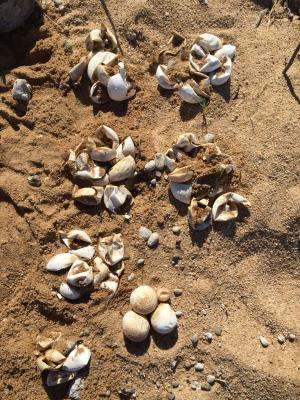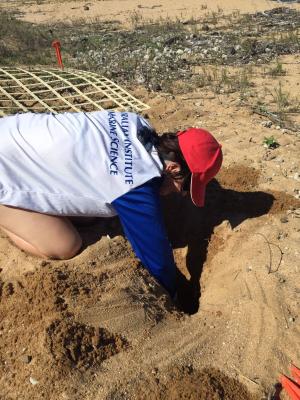When AIMS CEO Dr Paul Hardisty and his wife Heidi were walking on the beach outside AIMS headquarters at Cape Cleveland late last year, they were dismayed to see all the sea turtle nests had been raided by feral pigs, dogs and foxes.
Most sea turtles are endangered, and hatchings that make it to the water have a notoriously low survival rate to adulthood of about 1 in 1000.
Dr Hardisty put a call out to AIMS staff to volunteer to help protect this year's turtle nests from feral predators and 'Operation Gungu' was born. Gungu is the Bindal Traditional Owner name for turtle.
Answering the call was zoologist Dr Sara Bell, who had previous experience protecting nests through the Sea Turtle Foundation, and turtle expert Dr Amanda Dawson.

the successfully hatched eggs.
Photo: Nadine Boulotte
Together they ran training sessions for the around 20 Operation Gungu volunteers - including Dr Hardisty - who helped to build and install nest protection and undertake daily nest inspections before or after work.
The innovative training included teaching the volunteers how to read turtle tracks to locate the turtle nesting area and to determine if they successfully nested.
Dr Bell likens this to "detective work" as there are multiple clues to decipher to locate the nests, which are often difficult to pinpoint.
"Until you have worked with turtles at night, it's difficult to understand what they do," she said.
"During the day we are trying to follow the clues of the turtle tracks to determine which tracks are going up the beach, which are going down, and which nesting attempts are successful. Often a turtle will not lay if the sand conditions aren't right."
With Dr Bell's help, AIMS staff designed lattice structures of fibreglass poles lashed together and pegged down in the sand over the top of newly discovered nests.
"The aim is to prevent predators from digging up the eggs or the hatchlings during the 40 to 50-day incubation while allowing the hatchlings to pass through," she said.
"Predators become very interested in the nests when the eggs start to hatch as they give off a scent that allows the nest to be located.
"It can take a few days for the baby turtles to break out of their shells, uncurl, and dig their way to the surface where they simultaneously emerge and make a dash to the water. They are especially vulnerable to predators during this time.
"The turtles cover and camouflage their nests very well so it can be difficult to know exactly where to place the structures; but the protectors are large, so we put them over the most likely nesting spot, and, in most cases, we have captured the nest."

hatched nest to count the eggshells.
Photo: Nadine Boulotte.
Camera traps set up on the beach revealed that foxes are still a threat despite nest protection. Two protected nests were recently dug up and eaten as these predators were able to circumvent the lattice.
"Next year we will improve the protector design to ensure we exclude foxes," Dr Bell said.
Typically, turtles return to the same beach and nest several times (about every two weeks) between October and late December.
Dr Amanda Dawson said in previous years, all of the nests were destroyed by predators.
"This year we have so far protected 20 nests," she said.
"We had the happy news that the first baby turtles have emerged from three of those nests and, we estimate from empty eggshells and tracks on the beach, about 150 made it to the ocean.
"We look forward to more baby turtles emerging from their nests along the AIMS beach over the coming weeks, making it to the ocean safely, and growing to hopefully return here one day in the future."
AIMS staff are also working with Queensland Parks and Wildlife Service on a program to remove feral pigs and foxes from the site.
Featured image: Dr Sara Bell securing a turtle nest protector at AIMS Beach. Photo: Amanda Dawson.






